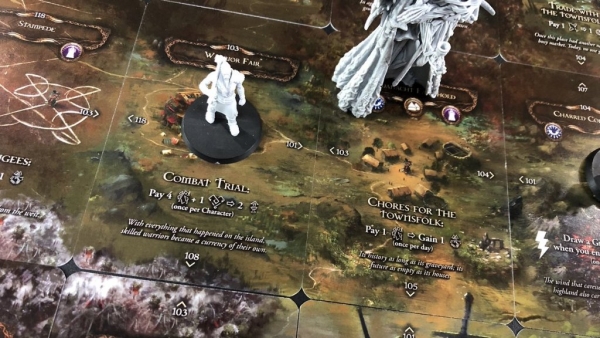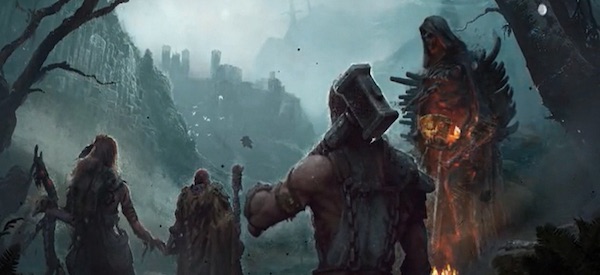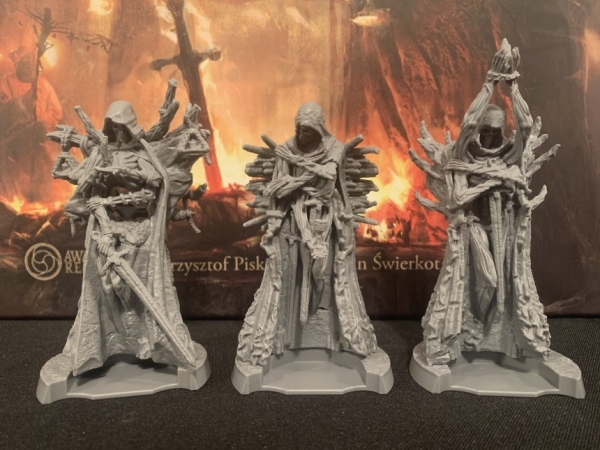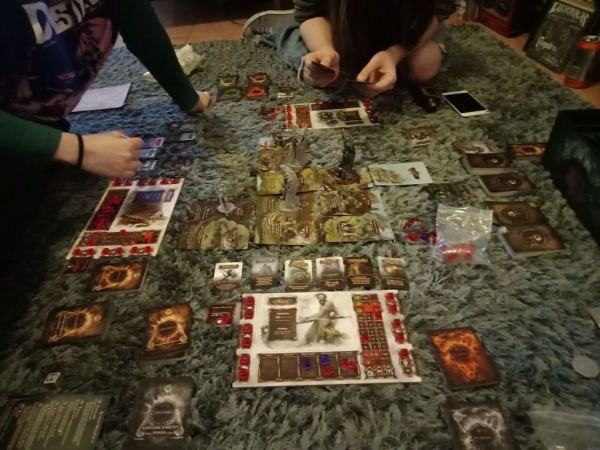The true cup of Christ or merely a grail-shaped beacon?
It was twenty odd hours into our quest for the grail. Over several weeks we had sought answers to its riddle amidst the mud and blood of a sundered Avalon, scavenging for sustenance and forging a hardscrabble existence on the fringes as we reluctantly slid into the ill-fitting boots of heroism.
Hemmed in on all sides by a creeping wyrdness, harried by the creatures of the realm, accused and assailed by a superstitious and starving populace. We were weary, we were chastened, we were squabbling amongst ourselves. The task seemed insurmountable, the rewards ill-formed and amorphous. On the precipice of surrender we packed away the remains of the day and wondered if we’d ever see the sun rise on a horizon devoid of toil and pregnant with possibilities. Exchanging a trio of knowing glances we laughed ruefully at the impossibility of it all.
Then we slid the box back onto the shelf and let out a loooong and deeply cathartic sigh of relief.

Keep your taint off my Grail
If the intent of prolific development wunderkinds Awaken Realms was for Tainted Grail to instil a sense of grinding, desperate privation and weariness in its players then they must surely be applauded for achieving new heights of thematic verisimilitude. After 21 hours divided across seven sessions I truly felt the burden of my avatar’s plight as I fastidiously assembled the components for play- not with relish and anticipation, but with a dogged sense of duty – for my investment, for this review, for the sunk cost and time fallacy that urged me onwards – even as I knew I’d almost rather be doing anything else.
This reluctant admission has swung and twisted as the game played out and my opinions shifted. Had I penned this piece after my initial fleeting forays upon this ancient soil it would have taken on a very different aspect, as initial impressions near enchanted as they flattered to deceive. A luxurious box, an abundance of cards, robust player boards, artfully sculpted miniatures and an intriguingly thick story book, all draped in beautiful art and design work greeted me seductively at first flush.
It was all so ludicrously promising.

And as we plunged into the wyrdness it seemed as though they had done it. Lightning in a bottle. An affirmation of big box ambition. Story and play enmeshed tightly in service of the sharpest hook of all- that of possibility. We were giddy as we unravelled its secrets and sat shaded by its dimensions. We were yet to parse that in its girth it not only offered a world, it straddled a contradiction.
To serve two masters
Drawing upon the influence and precedent set by kickstarter darling ‘The 7th Continent’, Tainted Grail is an evolution in the still emerging Exploration and Survival genre which that equally sprawling effort pioneered. It seeks to distinguish itself and iterate upon the formula by imbuing the game with a much richer and more involved narrative element, but in binding these elements together – it has not so much left seams that are visible as much as it has fashioned seams that ruffle to hessian-chafe the skin should this patchwork garment be worn for any real amount of time.
It’s at this point I must confess that my copy of The 7th Continent has been long since traded away. Whilst it promised a thrilling expedition to a lost world that would compel with its struggle to survive, in practice it seemed to embody nothing so much as a glorified analogue librarian simulator, almost causing me to reflexively utter a cautionary “shhh” through pursed lips as I was continuously compelled to flip through the indexed box of cards that would continue the story.
Rather than direct you to a similar dewey decimal indebted repository, Tainted Grail instead presents its voluminous ring-bound tome. As you traverse the shrouded land, each location will direct you to a passage in the book where you’ll be presented with a choose your own adventure selection of passages, many of which will be walled off by pre-requisites that must be tracked as you visit and re-visit these hamlets, swamps and battlements. The prose is uniformly well crafted here. Real effort has gone into creating a sense of setting and circumstance that draws you into proceedings. Which is just as well, as throughout the course of your travels, you’ll be doing a LOT of reading.

I understand the intent. No amount of card art can compare to the vistas conjured in the mind’s eye by a powerful piece of prose, and as writer I am always entirely appreciative of quality fluff text in enhancing the immersion of a thematic game. The issue here is one of scale.
For you see, reading is a solitary exercise. It requires its own pace. A chance to reflect and absorb. Tainted Grail meanwhile suggests that it should be enjoyed by 1-4 players. There are four player minis in the box (with a fifth as a kickstarter add-on). The sheer size of the components and number of variables to track indicates the workload and presence of a group activity. It is described and advertised as such. But having spent time in its company I wish I could now return to that initial flirtatious phase of our courtship and stride in alone. If I had a table big enough that is.
This is a solo game you guys.
More than just the storybook elements-its every conceit tilts towards the solitary, shifting uncomfortably under the harness of cooperative multiplayer. And nowhere is this more evident than in the encounter system.

A puzzling parlay with patience.
Another of the game’s boldest innovations, the combat and diplomacy encounters proudly eschew the dice-based resolution one might expect and instead opt for a card based strategic symbol matching system that like seemingly all elements of Tainted Grail, is touched by both genius and madness.
When confronted by an adversary, be it the fanged menace of a wyrdboar or the squabbling rhetoric of a local councilman, players will be tasked with drawing a hand of cards from either their combat or diplomacy decks and matching symbols on the edge of the adversary card in sequences that form escalating combinations. Options are limited by which cards are drawn and so the puzzle becomes an exercise in contingency, requiring forward thinking and optimisation whilst having a keen eye for the various possibilities inherent in different sequences, all while staggering your assault so as not to trigger the most crippling retributions.
It’s a fun and taxing brain-teaser each time as you ponder the possibilities, scrying the cards and playing out the odds in your head as you patiently and painstakingly eke out a victory or succumb to a winnowing defeat. Fun for the player involved that is. For the rest of the table it’s boring as shit.
But wait! You can act as a group! Sharing the encounter means you can each take turns to splay your best combinations on the table, taking advantage of the increased possibility that the greater pool of move-sets brings and cleverly collaborating to set up increasingly elaborate strings. It also means you get to take turns craning your necks and squinting at the miniscule text and symbols sat in front of the primary player, as you triple or quadruple the analysis paralysis of options that assail you and and one by one realise that holy shit this is totally a solo game.
With one player, the encounters become satisfying self-contained puzzles that one can take the time to breathe in and imbibe. As a group they are an administrative and logistical clusterfuck that just as often begets heated arguments rather than any satisfying symbiosis as inevitably someone pivots to quarterback.
In addition to this, the cards themselves have inbuilt character specific combo opportunities. For example- my character, the farmer Arev is equipped with a scythe and thus his deck is festooned with opportunities to ‘Reap’ which sets up a punishing denouement further down the line and ‘Sow’ which triggers said crescendo. However, with a baseline maximum of three cards in hand each turn, drawn randomly from a deck that spirals in depth and complexity as your character levels up- your ability to marshal these cards in the order required is left largely in the hands of fate, as turn after turn you struggle to make the most of your options in a demoralising succession of ‘if only’s’.

Heavy is the hand that lights the beacons
What of the exploration then? That initial sense of wonder as you plunged into the unknown and commenced your search, your journey? Intoxicating at first, the possibilities are enough to keep the game spinning latent in your brain of an evening. As you construct the world from the deck of beautifully illustrated tarot-sized cards, each new location entices and enthrals. Each new revelation both fills in the blanks and posits further questions as you seek to follow the trail set by your forebears into the mystery of a twisted and sickening isle. Without a pre-determined path to corral you, proceedings are imbued with a sense of freedom and agency that seems like it identifies your experience as truly your own.
It lends a feeling of authorship and the stones unturned each sing.
And then the menhirs start to fade.

Dotted throughout the map are a series of ancient sculptures, each imbued with the power to keep at bay the wyrdness that threatens to engulf everything in its baleful and toxic miasma. Settlements are constructed in the relative safety of these proximal environs and thus the kingdom of Avalon manages to stumble on meekly in the wake of this harrowing new age of darkness.
But the menhirs are fading, succumbing to corruption themselves. To keep them lit is an act of constant vigilance. And guess who has to do it?
Each turn will see a counter signifying the menhirs extant energies ticking down until the beacons are snuffed out. As they succumb to the darkness -so too does the surrounding landscape. In gameplays terms, this means every adjacent card and location is beholden to the fate of the menhirs- as should they go dark, every ancillary space is removed from the table. As your party traverses the world in pursuit of story objectives, their progress and path will be constantly dictated by the state of the menhirs that must be tended to lest they are snuffed and submerged, robbing you of passage. To activate or re-activate a menhir requires a sacrifice of resources – typically food, wealth and stamina- which you also need to explore, interact with encounters and y’know- stay alive. A generous evaluation of this mechanic would say it lends urgency to proceedings whilst ensuring the sprawl of locations never becomes too unwieldy. In practice however it feels much more like padding and busywork in service to that marketing dot-point proclaiming HUNDREDS OF HOURS OF GAMEPLAY. And even if that may be a stretch-it certainly does have the capacity to make three hours feel like a hundred.

Every time you are presented with an inviting new vista, or uncover a compelling new strand of the mystery to unravel, your progress will inevitably come to a grinding halt as you stop what you are doing to farm for resources that you might rewind the dial on one of these static sentinels.
And speaking of the dials. Fuck the dials. They’re one of the most impractical pieces of inscrutable kit I’ve ever had to squint over in my life. Huge pro-tip: replace them with a handful of six-sided dice at the outset and thank me later.
The busywork involved with this beast doesn’t just involve the menhirs either. There are so many moving parts to this game that the administrative side of things looms large over proceedings at all points. It becomes hard to get lost in an already fragmented story when one is keeping track of the myriad decks, dials and counters that signify and measure progression, any of which if fumbled or left untended can send the train careening off the tracks as the cogwheels of mechanism fail to click. It’s…exhausting. A chore. Especially if you’re gathered in a group and conscious of one another’s time.
It struck me in contemplating this mechanical baggage that not only is Tainted Grail a solo game- it’s a videogame. An ambitious open-world crafting and survival AAA big budget adventure video game spindled and warped in its transition to cardstock and tabletop.
Tellingly, it has already made that transition, and backers have been supplied with early access codes to a PC release that not only tracks the myriad complexities of the game more efficiently, but narrates the story for you, avoiding the spoilers that are prevalent when glancing through the book. And again, tellingly-it’s a solo experience.
I haven’t played it yet however; I still haven’t finished The Witcher.

One step forward…
As we become further enmeshed in what is surely and truly the golden age of tabletop gaming, we need to applaud the ambition on display as developers seek to take chances and escape the boundaries of established norms, pushing the envelope in an attempt to stand out, poking their head above the teeming throng that comprises an ever more crowded release schedule. Tainted Grail is more ambitious than most and as a pioneer of sorts we shouldn’t be surprised that it often stumbles.
If my tone throughout has bordered on condemnation then it is only as a reflection of experience clashing with my expectations, and indeed the expectations fostered by the box. There is a lot to love here – some of it even masterful, but it is splintered by a dichotomy that towers over everything like a signposting menhir or the breadth of the gamebox itself.
This hybrid novelty, this ambitious abomination is too solo for groups and too big for solo.
As a multiplayer game it tests the bonds and the patience of the group. Players are rarely served by splitting the party and following their individual muse and are all too often forced into passive acquiescence or to the role of a passenger.
As a solo game, I think it will shine, perhaps even scintillate. Unshackled to set your own agenda and pace, the solitary pilgrim will find much to soak in as they wend their way through the wyrdness.
But you better have an almost clerical predilection for stat tracking and admin.
And a fucking big table.

Insert Roxy Music Reference
In the end, the future of this kind of experience is yet to be written. With the staggering success of this effort we have already seen the first inklings of imitation in the likes of Mythic’s sure-to-be-broken, please-prove-me-wrong ‘Hel: The Last Saga’ and the further videogamification of the hobby seems assured as it strives to capture the same kind of audience and profit margins seen booming in that space. Tainted Grail may yet end up signifying the faltering first steps in a brave new direction, or an aborted evolutionary offshoot, shorn of its plumage by the winter of logistic fallibility. Time will tell. In the meantime, should you crave a story-rich socially-tilted multiplayer tabletop experience- the RPG space is also in the throes of a renaissance you would be well served investigating.

 Games
Games How to resolve AdBlock issue?
How to resolve AdBlock issue? 




























